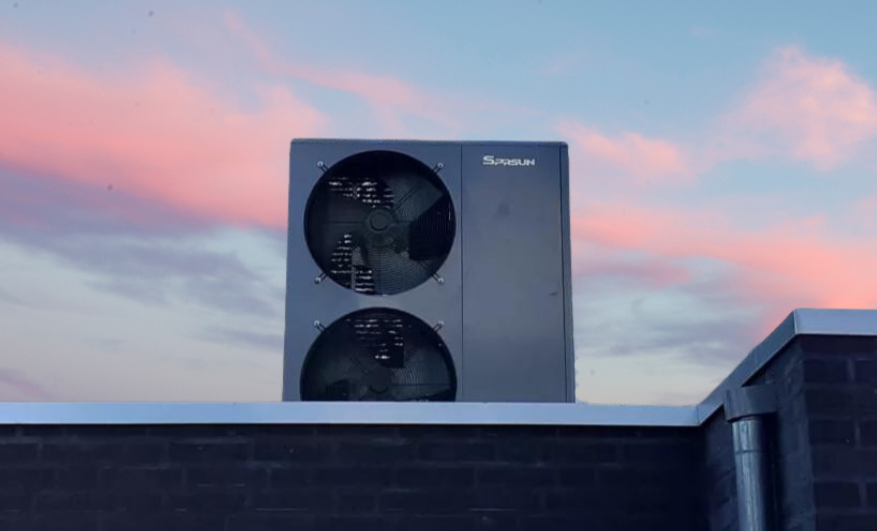How does a heat pump work?
Technical Explanation
The name of a heat pump already reveals something about how it works; it pumps heat. But where does the heat pump get its heat, and how is this heat released in a usable form? Heat pumps operate on the principle of evaporation (boiling) and condensation. To better understand this, let's first look at the evaporation and condensation of water.
Evaporation and Condensation
Under atmospheric pressure, water boils at a temperature of 100 ˚C. At the same pressure and a constant temperature of 100 ˚C, water continues to boil, or evaporate, forming steam. During boiling (adding heat), we can extract a lot of heat from the water/steam. If we use a pressure cooker to boil and evaporate the same water, the pressure, and thus the boiling point, is increased, and the water only boils at 120 ˚C. Conversely, if we place a glass of water under a vacuum bell jar, the water boils at 20 ˚C, requiring heat to be supplied, for example, from the surroundings. So, the boiling and condensation point of water depends on the pressure it is under. During boiling, molecules can escape from the water. The lower the pressure, the easier they can escape, and the higher the pressure, the more difficult. To make the molecules move faster, more energy/heat is needed. During heat removal or increasing pressure, the vapor condenses, releasing the previously added heat, and the steam condenses back into water, giving off heat.
- Evaporation (Boiling) = Add heat (Extract heat from a source)
- Condensation = Remove heat (Release heat to the surroundings or installation)
- Boiling of water - Explanation of the heat pump
A heat pump extracts heat from the surroundings according to this principle. Instead of water, the heat pump uses refrigerant, also known as Freon. The type of refrigerant used boils under atmospheric pressure at -48.5 ˚C. This refrigerant is brought into a liquid state in a closed system and pressurized in an evaporator at 8.5 bar, causing it to want to boil at 5 ˚C. If we pass outside air at 10 ˚C over this evaporator, warmer than the boiling point of the refrigerant, the refrigerant will boil and extract heat from the air. The cold air will cool, and the refrigerant will evaporate. The resulting vapor is sucked in by a compressor, which increases the pressure to 30 bar. The gas moves under this pressure to the condenser, where it wants to condense at 50 ˚C. If we now let water of 30 ˚C flow through it, below the boiling point of the refrigerant, the refrigerant will condense, releasing heat to the water and heating it up. After complete condensation, the refrigerant is reduced in pressure by an expansion valve, and the process repeats.
In this cycle, heat is moved. The energy needed to vaporize the refrigerant is obtained from the outside air. Electricity is required to drive the compressor. The added electrical energy is released in the condenser. The usable heat in the condenser is the heat extracted from the outside air to vaporize the refrigerant, plus the electricity consumption of the compressor.
- Heat pump extracts heat from the outside air
- Efficiency and COP of the heat pump
The only paid energy the heat pump needs is the electricity consumption of the compressor.
COP Calculation
The majority of the energy the heat pump needs is extracted from the outside air. In modern heat pumps, the ratio between electricity and energy from the outside air is 1 to 4, making a total of 1 + 4 = 5 parts. The COP is 5 in this case, with an efficiency of 500%.
- COP and efficiency of a heat pump
In this explanation, we extract heat/energy from the outside air, but it is also possible to use heat from the ground or a water source, resulting in a ground-source heat pump.
That is, in brief, how a heat pump works.
Step by Step - What Happens Exactly in the Heat Pump?
The heat pump consists of the following main components:
- Evaporator: In the low-pressure part, heat is extracted from a source to vaporize the refrigerant (boil), changing the state of matter from liquid to gas.
- Compressor: This component consumes electricity and enables the refrigerant to circulate under different pressures.
- Condenser: In the high-pressure part, the refrigerant condenses, releasing all added heat. This heat is absorbed by water flowing along the condenser and is used to heat buildings.
- Expansion Valve: An electronically controllable narrowing to reduce pressure. Before the expansion valve, the pressure is high, after the expansion valve, the pressure is low.
Applications of the Heat Pump
Increasingly, the heat pump is seen as the sustainable alternative to a boiler for heating homes. This is due to advantages such as a lower energy bill, reduced CO₂ emissions, and a comfortable indoor climate. When using green electricity or solar panels, there is no longer a need for fossil fuels.
A heat pump, powered by electricity that can potentially be generated by solar panels, makes it possible to achieve a Zero-Energy Home, provided the overall concept is sound.
The heat pump is highly efficient with electricity. For every kWh of electricity consumed, the heat pump produces 5 kWh of heat, sometimes even more. This is achieved by smart use of heat from the outside air, ground, or water. In comparison, a fully electric heater, such as an electric heater, produces only 1 kWh of heat for every kWh of electricity consumed. Therefore, a heat pump is 5 times more efficient.
A heat pump can be used for heating spaces and tap water, but also for cooling spaces. Applications can be found in homes, businesses, and even large hospitals and swimming pools.
Summary
By cleverly using physical principles, energy can be extracted that is already around us. Unlike burning fossil fuels, this process does not emit harmful substances. Electricity is needed to start this process. When this electricity is generated sustainably, the emissions are zero.






